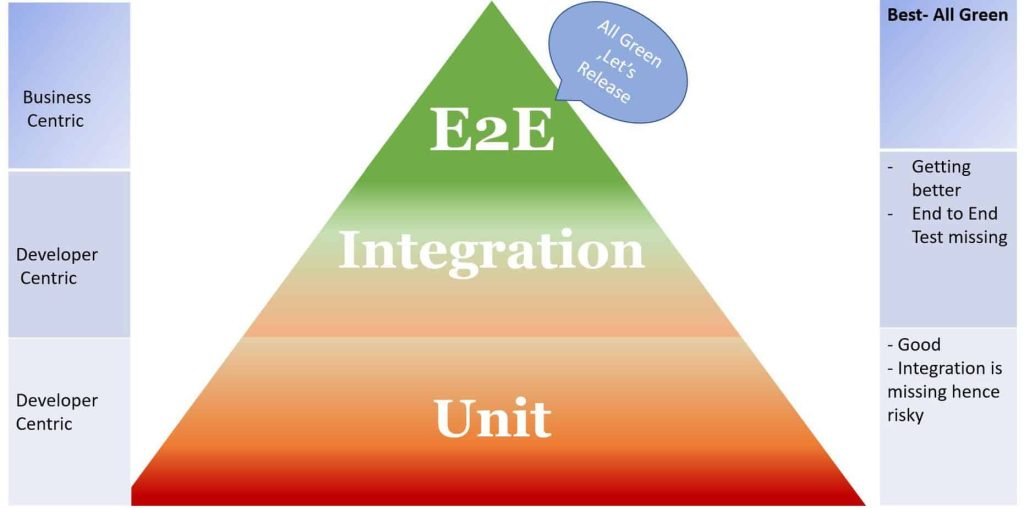Integration Testing Best Practices

Today in this article, we will understand Integration Testing and Integration Testing Best Practices in Agile software development methodologies. We will also understand the overall differences between Unit Testing Vs Integration Test Vs End To End Testing.
Today in this article, we will cover below aspects,

Integration Testing is one of the XP practices of software development.
In the world of Agile and continuous integration and continuous delivery/deployment (CI-CD) to make sure each functionality developed is of good quality, it’s of the highest importance that features are developed iteratively with a clear focus on Unit Test, Integration Test, and e2e testing as a whole.
Integration Testing is part of the software development phase in which individual software modules are combined and tested as a group as they are developed and evolved in small quantities at a time.
Release Day and Surprises!
Here instead of waiting until the release/deployment day ( for most of us the day of Judgment 😉 ) for formal Testing, functionalities are continuously tested within the development phase as they are developed and available.
The team keeps on integrating code even until the feature is complete.
The idea here is simple, issues are easy to fix when they are small.
Integration testing encourages small features to be integrated and tested in an incremental way.
Early Feedback – Saves COST, Quality, and Time
Early feedback saves your team’s effort. This saving is associated with efforts required for reverting build, resources, environments setup, etc. (known thing in water-fall or legacy-development ) which saves cost and time.
Merging code and other artifacts frequently, with automated tests flags any fragmentation quickly.
It’s important to understand that this phase’s real benefits can be realized within the development phase when things are evolving and being developed.
Integration Tests can be performed in the newly developed or existing legacy codebase.
Your Test suite developed can be run against,
- New features/Component/Software
- Enhancement
- Existing application(new/legacy)
Your Unit Test cases act as state machines for your applications. Your test suite in any form will protect your code from anomalies and breaking changes apart from making new code robust and compatible with existing code.
This phase complements Unit Testing and End to End testing phases and helps in implementing functionality making robust software products.
Let’s understand a typical Test Pyramid.
It’s very much clear from the below pyramid that each phase has its role and responsibilities and each phase complements the other.
Once the business requirements are clarified through either established processes.
Example:
BDD (Behavior Driven Testing) or
ATDD(Acceptance Test Driven Development),
the next step is to perform core Test Driven Development) which involves both Unit Testing and Integration testing.
The FIRST thing you do is Unit Testing using the FIRST principle (Please see this article on understanding the scope of Unit Testing in detail ).
Integration Testing will do everything else which is not in the scope of Unit Testing.
Scope of Unit Testing Vs Integration Test
The scope of Unit Testing is limited to the function or method.
In short, a Unit of work within a Class mainly has its function.
Each individual API/Function will be tested for business logic by using their input, and outputs (I/O) with all possible scenarios ( which include +ve and -ve test cases).

Unit Test is the FIRST thing you should do to make your application robust.
Tests are termed as Units because here the emphasis is on each individual piece of logic tested in isolation for its completeness.
Each small individual Method/Functions are important and hence needs to be tested in isolation.
Scope of Integration Test Vs Unit Test and Functional Test
Certainly, few things are not in the scope of Unit Testing and hence need to be addressed in the Integration Testing.
Ex. Workflow from one component to other components.
It’s important to check if one module which is built separately works as expected when used with another module.
All data communication between components including below needs to be tested,
- I/O or network resources
- File systems
- Databases will be used for performing Integration testing.
- Network Component (HTTP, Security, TCP/IP)
Integration Testing at the end will flag for final System Testing.
Here below shows a visual diagram on why integration test is important and how it is important to identify them in an early stage to avoid extra re-engineering of the functionality,

API Virtualization and role in Integration Testing
API virtualization is another important aspect of Integration testing of your Downstream and Upstream components. Please visit the below article for more details,
E2E Testing
There are things that will not be in the scope of Integration Testing and hence needs to be tested in System or End to End Testing.
Regression Testing or End to End Testing will be performed against the deployable unit which runs in an environment (which is similar to the actual Production or Test or Dev environment).
Here more emphasis is on business workflow execution as per defined parameters.
This phase is generally executed only after the feature is implemented fully.
Along with rigorous business scenarios testing, E2E involves environment creation, package deployment, Test data management, etc.
Best Practices
- While considering the Integration Testing consider components or portions of the component which will interact with other components.
- Example: If developing RESTFul API/service, then you should write an Integration test for all exposed endpoints. You validate service endpoints for business logic, HTTP response codes, database connection, etc.
- Integration Testing should run quickly and should be less time-consuming.
- The only permutation of the scenario can be considered for Integration testing.
- For example – if developing Service validates only basic CRUD operations etc.
- Integration Testing should be executed when development/enhancement is in progress. Early feedback is the key here.
- A successful Unit + Integration Test run can be used as a go-ahead for E2E/Functional Testing. No doubt, this will give the team a good level of confidence.
- The integration Test should be environment-agnostic. Ideally, tests should run in any environment as needed.
- Integration Tests should be performed using real resources as possible. Examples- Database, Network resources, middleware Security, infrastructures, etc.
Where to Start?
Answer: New development. There is always confusion among Developers on where do I start. ?
Should we start with the UI layer or the Middle layer, etc?
However, It should be of less significance.
You should consider any new development (new application or even any new feature within the existing application or existing legacy enhancement) as your target Software Under Test (SUT).
We are aware of Top-Down or Bottom-up approaches. But in real enterprise application development, it’s difficult to follow one particular approach. One may never know where requirements will arise.
Hence the best approach would be to consider a mixed approach with agile practices.
Let’s have the mindset of developing anything new using the best practices. New development should do all tests including Unit + Integration + E2E.
Other references :
Do you have any comments or ideas or any better suggestions to share?
Please sound off your comments below.
Happy Coding !!
Please bookmark this page and share it with your friends. Please Subscribe to the blog to receive notifications on freshly published(2024) best practices and guidelines for software design and development.
A good insight on Integration testing. Thank you!
Thank you Michael. Appreciate your feedback.